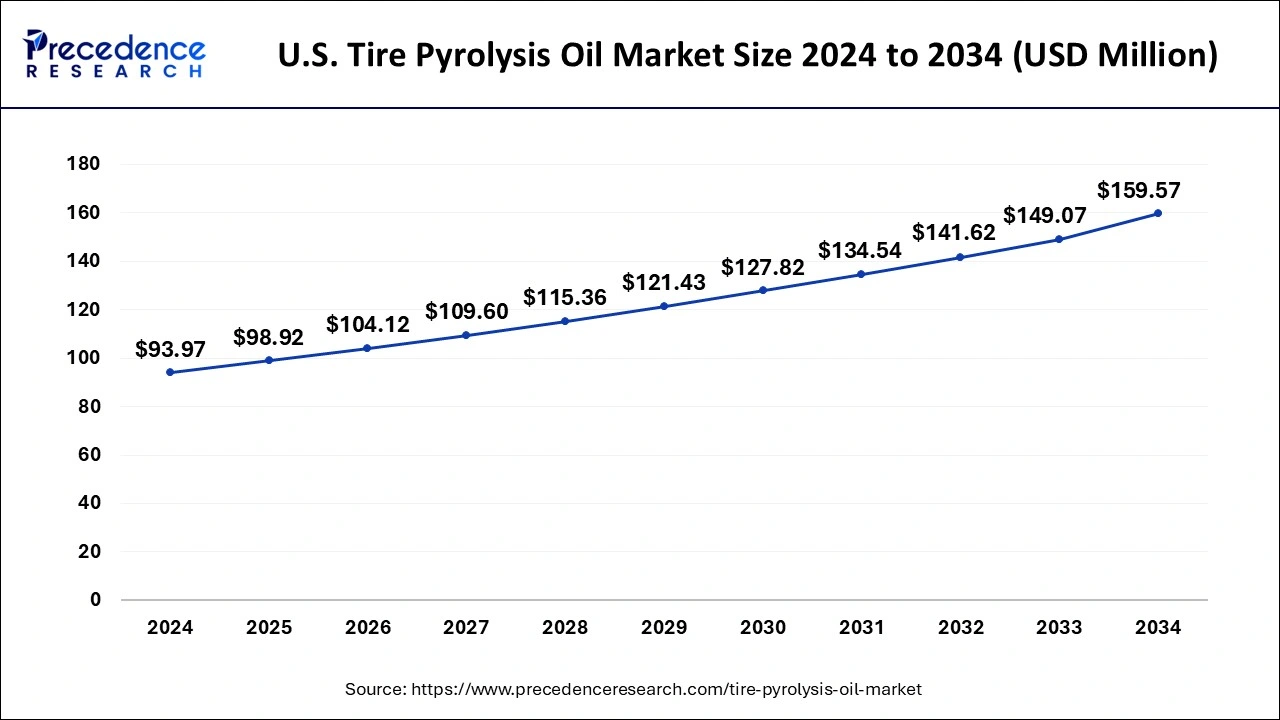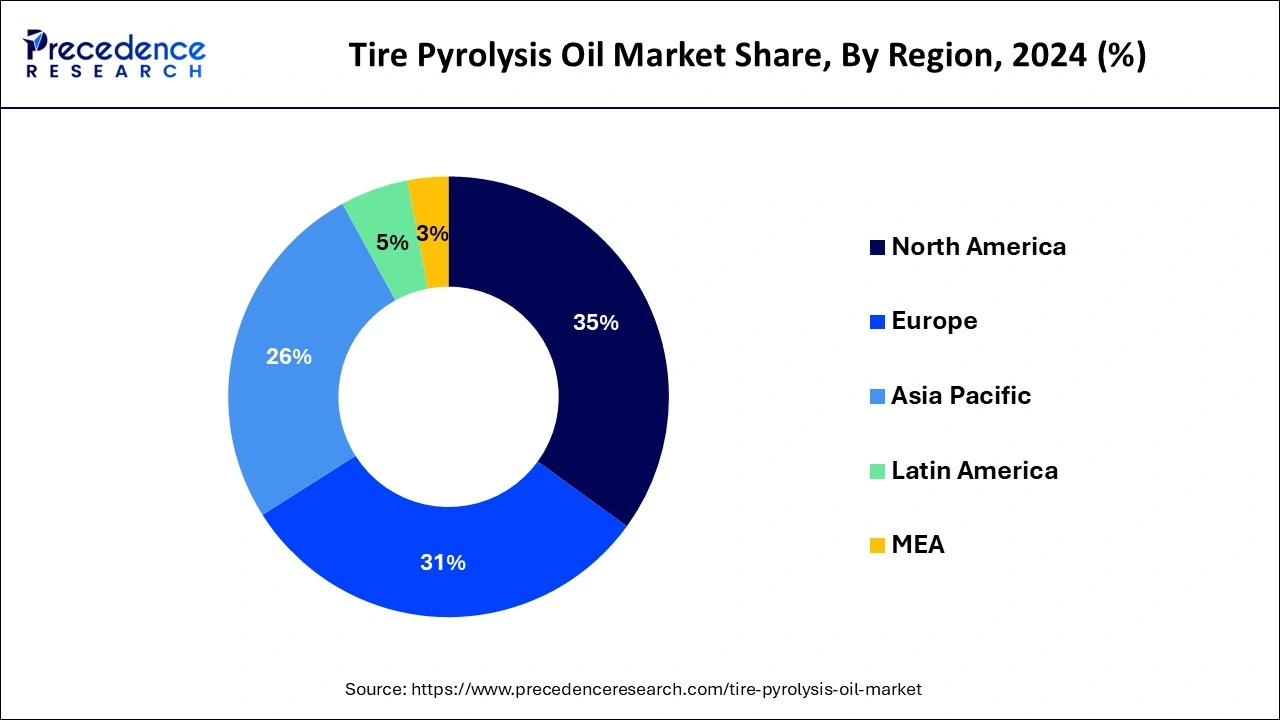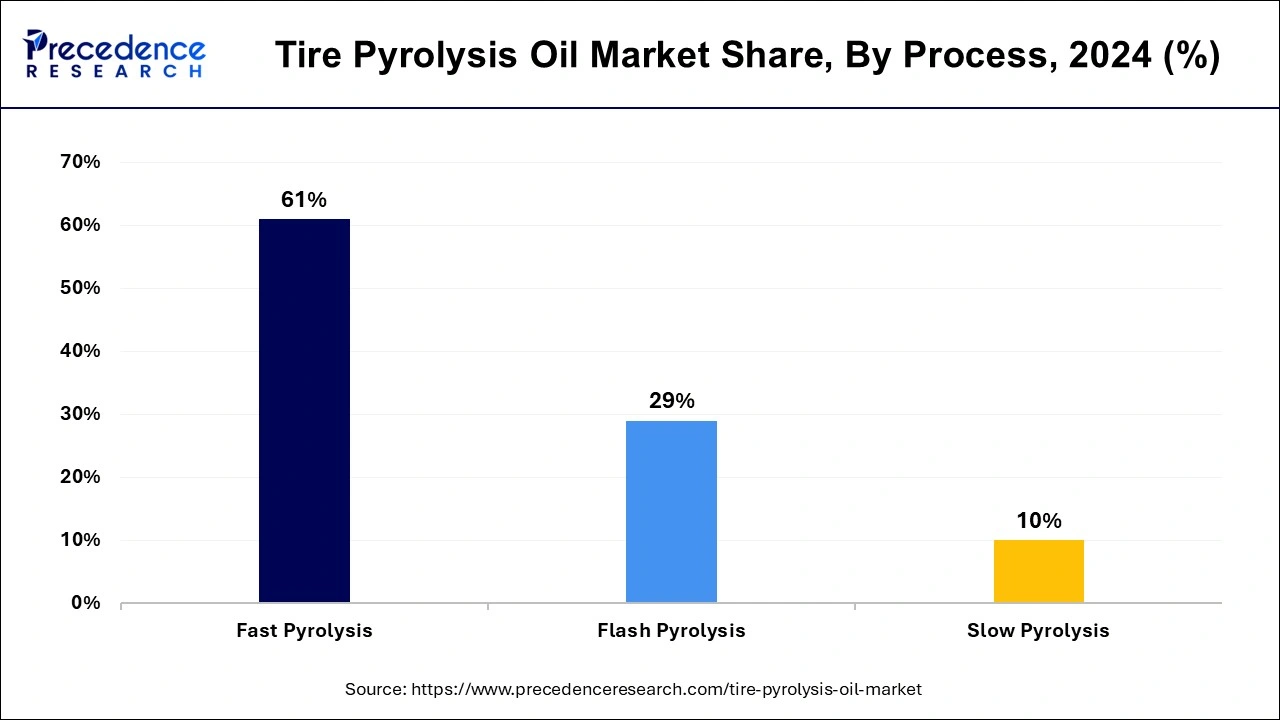Tire Pyrolysis Oil Market Size and Forecast 2025 to 2034
The global tire pyrolysis oil market size was estimated at USD 357.99 million in 2024 and is predicted to increase from USD 376.82 million in 2025 to approximately USD 595.34 million by 2034, expanding at a CAGR of 5.22% from 2025 to 2034.

Tire Pyrolysis Oil Market Key Takeaways
- The global tire pyrolysis oil market was valued at USD 357.99 million in 2024.
- It is projected to reach USD 595.34 million by 2034.
- The tire pyrolysis oil market is expected to grow at a CAGR of 5.22% from 2025 to 2034.
- North America held the dominant share of over 35% in 2024.
- Asia Pacific is observed to expand at a rapid pace during the forecast period.
- By Process, the fast pyrolysis segment held the largest share of 61% in 2024.
- By Process, the flash pyrolysis segment is expected to grow at a robust growth rate during the forecast period.
- By Raw Material, the waste plastic segment accounted for the dominant share of 41% in 2024.
- By Raw Material, the waste rubber segment is expected to witness a significant share during the forecast period.
- By End Use, the fuel segment held the dominating share of the market in 2024.
U.S.Tire Pyrolysis Oil Market Size and Growth 2025 to 2034
The U.S. tire pyrolysis oil market size surpassed USD 93.97 million in 2024 and is expected to be worth around USD 159.57 million by 2034 at a CAGR of 5.44% from 2025 to 2034.

North America held the dominant share of the tire pyrolysis oil market in 2024. The region is observed to witness notable growth during the forecast period. The growth of the region is majorly driven by the increasing emphasis on eco-friendly and sustainable sources of energy, the sophisticated infrastructure of tire pyrolysis oil plants, and the increasing adoption of advanced technology by tire waste management companies.
The tire pyrolysis oil market has witnessed several research works on the pyrolysis of automobile tires in waste and increased government investment in the search for alternative fuels. The United States is the major contributor to the market due to its robust regulatory system and rapidly rising awareness of the necessity to reduce carbon emissions by replacing fossil fuels.
The United States generates a considerable volume of waste tires annually as being one of the most industrialized nations. Many market players utilize this resource to establish pyrolysis plants and obtain tire pyrolysis oil. Additionally, the government offers support and incentives to encourage using tire pyrolysis oil as diesel. Therefore, a growing focus on sustainable development and environmental protection is expected to propel the market demand for tire pyrolysis oil in the region, contributing to its growth.
- In August 2023, InnoVent Renewables launched in the U.S. to recycle waste tires using a continuous pyrolysis process. It aims to accelerate using renewable energy sources by recycling waste tires. InnoVent Renewables has announced its launch in the U.S. The company will utilize its continuous pyrolysis technology to convert end-of-life tires, plastics, and biomass into reusable fuels and chemicals.

Asia Pacific is expected to expand at a rapid pace during the forecast period. Developing countries such as India, Japan, and China have implemented stringent regulations on tire disposal and an increasing focus on clean energy as an eco-friendly alternative to conventional fossil fuels. These resources can ease energy shortages and create enormous economic benefits.
The growth of the tire pyrolysis oil market is positively impacted by government regulations and incentives aimed at promoting environmental practices and reducing carbon emissions. In addition, companies are highly investing in continuous waste tire pyrolysis plants as a profitable business, and partnerships and collaboration among government agencies, industry players, and research institutions are likely to supplement the market growth in this region.
- In June 2023, Bridgestone Corporation announced that it had commenced the production of tire-derived oil and recovered carbon black through pyrolysis of used tires using test units installed at Bridgestone Innovation Park in Kodaira City, Tokyo. This initiative is aimed at promoting the social implementation of chemical recycling technologies that enable precise pyrolysis of used tires.
- In August 2023, Henan Doing Company, a leading manufacturer and supplier of waste pyrolysis equipment, completed the installation of a new technology 50TPD fully continuous tire pyrolysis equipment in India. This pyrolysis project can help our Indian client make great economic and environmental benefits from waste tire recycling.
Market Overview
Energy waste has become a growing concern when it comes to selecting alternate fuels. To prevent discarded automobile tires from harming the environment, it is important to find a way to recycle them in a useful manner. Many initiatives have been taken around the world to replace gasoline and diesel fuel due to the fossil fuel crisis, rising international crude oil prices, and strict emission regulations. Recently, the disposal of waste tires from vehicles has gained significant attention as people have started to recognize the potential of tire pyrolysis oil as an eco-friendly alternative to traditional fossil fuels.
Tire pyrolysis oil is a heavy oil or crude oil that can be extracted from waste tires through the pyrolysis process. After the conversion of tire pyrolysis oil to diesel, it can be used in large vehicles such as trucks, trailers, tractors, generators, and heavy machinery. Tire pyrolysis oil is commonly used as an alternative fuel because it has similar physicochemical properties to diesel fuel. The physicochemical properties of tire pyrolysis oil have an impact on the combustion, performance, and emission of diesel engines. Tire pyrolysis oil is obtained by pyrolyzing end-of-life tires and contains valuable chemicals such as toluene, benzene, ethylbenzene, xylene (BTEX), and limonene.
The use of tire pyrolysis oil as a substitution for diesel fuel offers an opportunity to reduce the utilization of natural resources. Globally, several research studies have been carried out on the pyrolysis of automobile tires that are contaminated with waste. Three main products can be obtained from continuous waste tire pyrolysis plants: tire oil, carbon black, and steel wire. Each product has a wide range of applications.
Tire Pyrolysis Oil Market Growth Factors
- The increasing international crude oil prices majorly drive the growth of the tire pyrolysis oil market as an appealing alternative for companies actively looking for cost-effective energy sources.
- The growing focus on environmental consciousness globally increases the demand for secure, sustainable, and eco-friendly alternatives to traditional fossil fuels.
- Governments worldwide have introduced numerous laws to reduce carbon emissions and promote the use of alternative fuels, driving the growth of the tire pyrolysis oil market.
- The increasing acceptance of advanced technology is anticipated to contribute significantly to the global tire pyrolysis oil market revenue. The rapidly ongoing innovation in tire pyrolysis processes enhances efficiency, yield, and oil quality.
- The increasing application of tire pyrolysis oil as an alternative fuel is anticipated to accelerate the market's revenue during the forecast period. Tire pyrolysis oil is used in numerous industrial activities such as electricity generation and heating and as a feedstock for chemical processes.
Market Scope
| Report Coverage | Details |
| Growth Rate from 2025 to 2034 | CAGR of 5.22% |
| Market Size in 2025 | USD 376.82 Million |
| Market Size by 2034 | USD 595.34 Million |
| Largest Market | North America |
| Base Year | 2024 |
| Forecast Period | 2025 to 2034 |
| Segments Covered | By Raw Material, By Process, and By End-use |
| Regions Covered | North America, Europe, Asia-Pacific, Latin America, and Middle East & Africa |
Market Dynamics
Driver
Rising environmental concerns and rising demand for eco-friendly solutions
The rising environmental concerns and rising demand for eco-friendly solutions are expected to boost the growth of the tire pyrolysis oil market during the forecast period. Growing environmental awareness is enhancing the need for sustainable and environmentally friendly alternative fuels. Tire pyrolysis oil (TPO) is derived from waste tires from automotive vehicles.
Tire pyrolysis is an innovative process in waste management and represents an eco-friendly and sustainable solution to the global challenge of tire disposal. This waste management solution addresses the environmental hazards posed by tire waste and harnesses the potential of recycling for economic as well as energy benefits.
The tire pyrolysis oil market assists in mitigating the ecological impact of tire waste through thermal decomposition and reduces dependency on conventional fossil fuels. Tire pyrolysis oil can be used for energy generation or as a feedstock in various industries such as cement factories, power-generating factories, steel factories, glass factories, and others. It is an excellent alternative energy to traditional petroleum-based crude oil. Thereby driving the market's growth.
Restraint
High initial investment
The high initial investment is anticipated to hamper the growth of the market. The tire pyrolysis oil factory necessitates a substantial initial investment in equipment and technology, which can be expensive for many potential tire pyrolysis oil market entrants. Moreover, the supply of scrap tires can be variable and volatile, which may influence the continuous supply of raw materials. Such factors may limit the adoption and expansion of the global market.
Opportunity
Supportive government policies and incentives
Governments around the world have implemented various laws to reduce carbon emissions and promote the use of renewable and alternative fuels. This has created a huge opportunity in the market. Supportive government policies and incentives, such as tax breaks and subsidies for tire pyrolysis oil production and usage, are driving the expansion of the tire pyrolysis oil market. By adopting a safe, affordable, and sustainable energy solution, governments are taking a step towards a better future.
Moreover, the tire pyrolysis oil market is increasingly gaining traction due to the rising international crude oil prices. Tire pyrolysis oil emerges as a relatively lower-priced alternative. It requires lower production costs and reduces reliance on limited resources, which significantly increases the adoption of tire pyrolysis oil as an alternative fuel.
Raw Material Insights
The waste plastic segment accounted for the dominating share of the tire pyrolysis oil market in 2024. Waste plastic is one of the abundant forms of feedstock for tire pyrolysis. As plastic production and consumption expand globally, there is a steady and adequate supply of plastic trash accessible for recycling via pyrolysis methods. This ensures a consistent supply of raw materials for the manufacture of tire pyrolysis oil. Furthermore, plastic materials have a high energy content, making them an appealing feedstock for pyrolysis. This means that the oil produced by plastic pyrolysis has a higher energy density than traditional feedstocks, making it a useful source of fuel and chemicals.
During the forecast period, the waste rubber segment is expected to witness a significant share. This segment deals with rubber recycling, wherein irreparably damaged rubber products are processed for new use, thus preventing rubber waste from ending up in landfills. The process requires less energy than producing new rubber and helps reduce environmental pollution.
Process Insights
The fast pyrolysis segment held the largest share of the tire pyrolysis oil market in 2024. Fast pyrolysis yields more tire pyrolysis oil, and increased TPO with reduced production cost boosts efficiency. Fast pyrolysis uses very high heating rates, short residence times, and rapid quenching of vapors to enhance the production of the liquid product.

The fast pyrolysis segment accounted for the largest share of the tire pyrolysis oil market in 2024. This method is preferred because it yields more tire pyrolysis oil, which boosts efficiency while reducing production costs. Fast pyrolysis is achieved by using high heating rates, short residence times, and rapid quenching of vapors, all of which enhance the production of the liquid product.
End-use Insights
The fuel segment has dominated the tire pyrolysis oil market in 2024. This growth is attributed to the increased use of tire pyrolysis oil as an alternative to diesel fuel, which helps to reduce the consumption of natural resources. Pyrolysis oil is a type of heavy fuel oil that can be refined and transformed into diesel for several applications. These applications include use in heavy machinery, generators, tractors, big trucks, trailers, and more.
Tire Pyrolysis Oil Market Companies
- Alterra Energy, LLC
- Bridgestone Corporation
- Daeho Industries
- Bioenergy Ae Cote-Nord
- Ensyn
- Green Fuel Nordic Oy
- Pyro-Oil Nig.Ltd.
- Mk Aromatics Limited
- New Energy Kft.
- New Hope Energy
- Nexus Circular
- Trident Fuels (Pty) Ltd
- Plastic Advanced Recycling Corp.
- PLASTIC ENERGY
- Setra Group
- Quantafuel ASA
- Trident Fuels Pty Ltd.
- Twence
- Klean Industries Inc.
- BTG Biomass Technology Group
- Agile Process Chemicals LLP
Recent Developments
- In February 2024, BASF unveiled plans to bring products made through its ChemCycling advanced recycling system to market in the United States, and the company will implement its advanced chemical recycling methods used to make recycled plastic feedstocks at its TotalEnergies petrochemicals facility in Port Arthur, Texas.
- In April 2022, SK Energy, SK Networks, and Daeho Industries met at the Daeho Industries factory in Gwangju, South Korea, to sign an agreement for a pyrolysis business by recycling waste tires. SK Networks will be in charge of collecting waste tires and improving the supply system. Daeho Industries will operate the facilities for waste tire pyrolysis and develop measures to utilize the carbon black.
- In March 2023, Cabot Corporation introduced Vulcan 7H-C, its first ISCC PLUS-certified circular reinforcing carbon made from tire pyrolysis oil sourced from end-of-life tires and renewable materials to reduce greenhouse gas emissions.
Segments Covered in the Report
By Raw Material
- Waste Plastic
- Waste Rubber
- Wood
- Oil Sludge
- Others
By Process
- Fast Pyrolysis
- Flash Pyrolysis
- Slow Pyrolysis
By End-use
- Fuel
- Chemicals
- Others
By Geography
- North America
- Europe
- Asia-Pacific
- Latin America
- Middle East and Africa
For inquiries regarding discounts, bulk purchases, or customization requests, please contact us at sales@precedenceresearch.com
Frequently Asked Questions
Ask For Sample
No cookie-cutter, only authentic analysis – take the 1st step to become a Precedence Research client
 sales@precedenceresearch.com
sales@precedenceresearch.com
 +1 804-441-9344
+1 804-441-9344